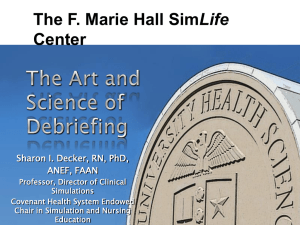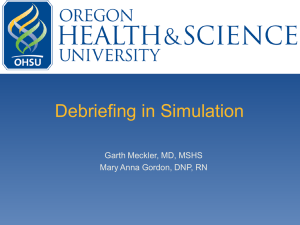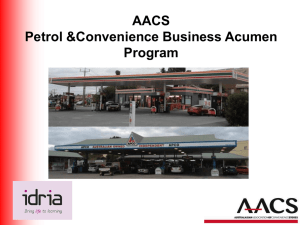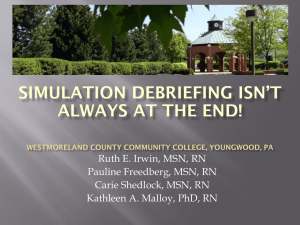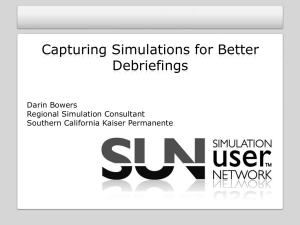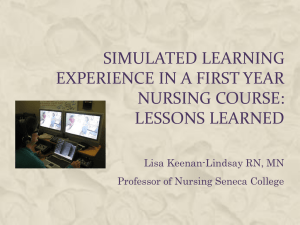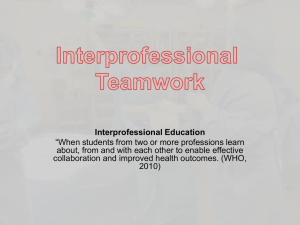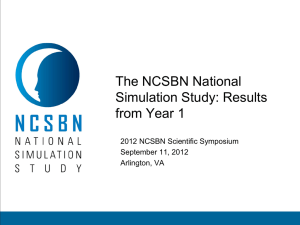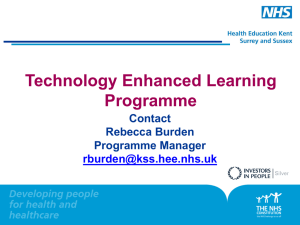Tim Hardy, EMS Lab Coordinator for Blinn College
advertisement
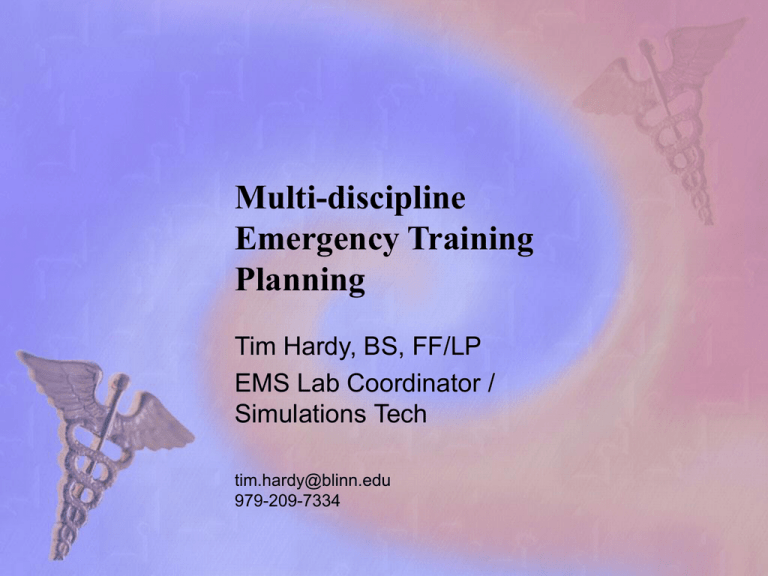
Multi-discipline Emergency Training Planning Tim Hardy, BS, FF/LP EMS Lab Coordinator / Simulations Tech tim.hardy@blinn.edu 979-209-7334 Objectives • Recall the components necessary to plan and facilitate multi-disciplinary training using simulation • Discuss relevant opportunities for multi-disciplinary training. • Discuss obstacles for multidisciplinary training and potential solutions to overcome those barriers. Blinn College Health Sciences • • • • • • ADN Program VOCN Program EMS Programs PTA Programs Surgical Tech Programs Rad Tech Programs •Dental Hygiene •Vet Tech Simulation Impact at Blinn 208 ADN 30 VOCN 195 EMS 15 Surg tech 30 Rad tech 50 PTA 528 students a year Blinn College HSC August 2011 Simulation 9 Step Process 1. Identify the need. 2. Identify all the players. 3. Develop the measurable goals. 4. Determine the environment. 5. Understand the technology. 6. Develop & validate the scenario. 7. Implement the scenario. 8. Analyze the data & debrief. 9. Did you solve the problem? (Reflect) All humans make mistakes. Healthcare workers are human. Healthcare workers make mistakes. ~ Dr. Meera Kelley Identify the Problem • Define objectives and goals. • What are the areas of concern? • What do you hope to accomplish? • What options are available? • What have you tried? Results? • Is funding available? Identify the Players • Who are the stakeholders? • Community or in house? • Single discipline or multiple? • Who does the problem effect (directly or indirectly)? • Is the problem small or big? Develop the measurable goals • Outlines a purpose. • Look for measurable processes. • Defines educations role. • Insures all pertinent information is being passed on. • Allows for a formalized debriefing process to be developed. Understanding the environment • What group of clinical professional are your target? • Scope of Practice or Service? • Do you have all of the necessary equipment? • Alter measurable processes… Understanding the technology • Physiology Model or Instructor Driven • Computer Game vs. human sim • Haptic • 3D immersive or Wii? 3 Event Scenario • Pre-Event Briefing • Event Management • Post-Event Review (Debriefing) Types of Simulations • Computer-Based Simulation • Haptic Simulation w/ Haptic Simulators • Virtual Reality Simulation (Full Immersion Simulation) • Full Body Simulation • Standardized Patients Computer-Based Simulation Haptic Simulation – Virtual IV Full Body Simulation Insert pic of standardized patient Types of Simulators • Partial Task Physical Trainers • Haptic Simulators • Full Body Simulators – Instructor driven Simulators – Physiologic Model driven Simulators Develop & validate the scenario • After developing goals and objectives. • Translate real world situations. • Have a process for testing / evaluating the scenario Programming the Scenario Implement the scenario • Have the learners work through the case. • No interruptions… • Be safe. • Have a program facilitator watch and grade. Simulation Rules of Engagement Code of Conduct • Patient is real • No torpedoes / bombs • Support only when requested • Never discuss performance outside the simulation / debriefing Debriefing Rules of Engagement Code of Conduct • Follow “Initial Goals and Objectives” • Maintain Privacy • Follow Adult Learning Principals • Have a backup plan – (In case of a change in the participants behavior or actions that need to be addressed) • Be open to changes in the Sim Analyze the data & debrief • Facilitate a discussion on the experience. • Provide information on their performance. • Site examples. • Utilize video recordings to reflect and reinforce. • Discuss – Discuss – Discuss DEBRIEFING “Feedback that enhances learning.” Debriefing Objectives • Reflective learning • Focus on performance, not performer • Safe environment to express feelings and ask questions • Link what has been learned in the simulated setting to the “real world” Video of Simulation for Debriefing • Students must know in advance that they are being videotaped how it will be used and when it will be erased • Signed permissions • Should you erase the tape after the debriefing? • If kept for viewing by others, permission needs to be provided by students Video Debriefing • Tag a moment for instant return – Mark a situational event – Flag for review • Annotate points in time – Text and Audio notes • Screen shot of debriefing video Successful Simulation Debriefing • Improves communication (SBAR) • Improves team work skills • Improves awareness through clarity of roles/responsibilities • Improves information sharing • Eliminates barriers to quality and safety • Increases positive outcomes • Reduces errors • Creates a culture of safety Successful Simulation Debriefing cont…. • Examine the entire simulation process. • Obtain feedback from the students, instructors, and operators. • Examine how the simulation impacted the program. Was the original problem solved? • Did you change any process or a step within the entire process? Simulation Opportunities • • • • • • • Collaborate with other departments Look for partnerships Apply for grants (NIH, AHRQ,NLN) Mass Casualties…how many organizations are present? Who is impacted? Join a consortium… Share your experience Integration Simulation • • • • • • • • • • EMS LVN ADN Rad Tech Surg Tech Respiratory Therapy Fire Science Vet Tech Dental Hygiene Others….. Integration Simulation cont… • • • • Know each programs capabilities Coordinate objectives together Allow students to help write the scenarios Purchase equipment together • Pic of multi scenari Obstacles….. • The Nay Sayers • Be prepared to explain to others how their students can play in • Over come resistance of integration • May need to ask what other do so that you know how they can play in to simulation. • MONEY!!! • In house champions • Buy In (bottom to top or top to bottom?) Review • Discussed the components necessary to plan and facilitate multi-disciplinary training using simulation • Discuss relevant opportunities for multi-disciplinary training. • Discuss obstacles for multidisciplinary training and potential solutions to overcome those barriers. Any Questions? Contact information: Tim Hardy, BS, FF/LP Blinn College 979-209-7334 tim.hardy@verizon.net

